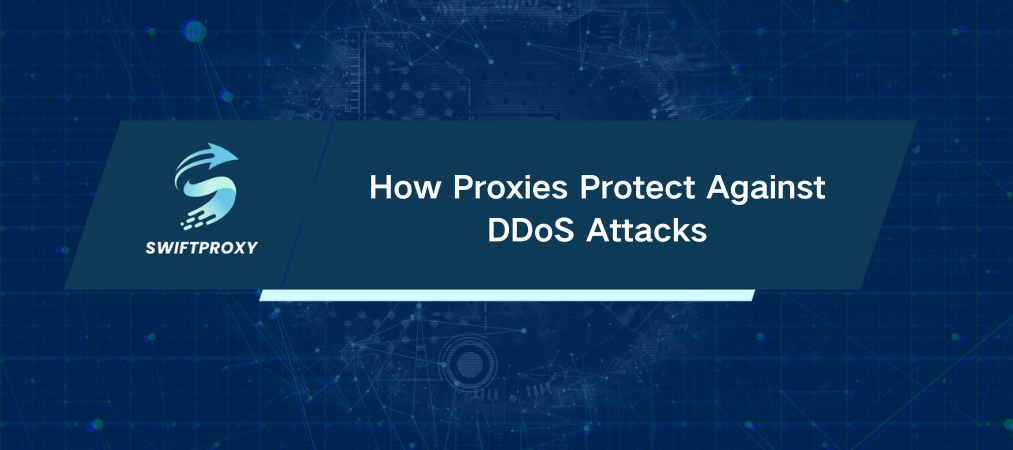How Proxies Protect Against DDoS Attacks

Imagine that your website suddenly grinds to a halt. Not because of a surge in customers, but because millions of fake requests have slammed your server like a tidal wave. This isn't a nightmare scenario—it's a Distributed Denial of Service (DDoS) attack. And it's one of the deadliest threats to online businesses today.
Every minute your site stays down you lose money. Trust evaporates and customers walk away. The damage is real and fast. So how do you fight back? Anti-DDoS proxies act as silent guardians standing between your server and the flood of malicious traffic.
These proxies don't just block attacks. They stop harmful traffic before it even reaches your core systems. They act like gatekeepers, filtering, redirecting, and balancing traffic to keep your services online no matter what chaos erupts outside.
In this article we'll break down how these proxies work, the types you need to know, and how to configure them for maximum protection. Spoiler alert securing your network isn't optional anymore—it's mission-critical.
Introduction to DDoS Attack
At its core, a DDoS attack is a blunt instrument designed to overwhelm. Thousands, sometimes millions, of fake requests hit your server simultaneously, choking its ability to respond. The result? Your website freezes—no access for real users, no transactions, no service.
How does this happen? Cybercriminals hijack countless devices—computers, routers, even smart gadgets—to form botnets. These zombie armies launch automated waves of traffic from all corners of the globe. Without defenses in place, your server simply can't keep up.
Large-scale attacks can last hours or days. However, you can't just block all traffic. You need to separate genuine users from hostile bots. That's the tricky part.
How Proxies Turn the Tables on Attackers
Here's where proxies shine. They shield your server's true IP address, making it invisible to attackers. Instead of letting every request hit your main server, all traffic funnels through the proxy first.
The proxy scans every packet. Suspicious? Blocked. Safe? Passed along. This active filtering stops threats early and keeps your server breathing. Plus, by spreading requests across multiple servers, proxies prevent any one machine from buckling under pressure.
Think of proxies as traffic controllers for your network. They don't just block attacks; they manage legitimate traffic so your users don't feel the impact.
Why Anti-DDoS Proxies Are a Game-Changer
These specialized servers do more than just basic filtering. They analyze traffic patterns—how often requests come in, where they originate, and what they look like. That insight lets them spot and neutralize attacks in real-time, even when bots use sophisticated tricks like IP rotation.
The biggest win? Your infrastructure stays intact. For businesses running e-commerce platforms, financial services, or SaaS applications, uptime isn't just a goal—it's a lifeline. Anti-DDoS proxies keep that lifeline steady.
Reverse Proxy Defense
Reverse proxies add another layer. They handle incoming requests, serve cached content to reduce load, and dynamically distribute traffic across servers. On top of that, they monitor for any signs of active threats.
When a traffic spike hits, reverse proxies don't panic—they serve cached pages to real users while scrutinizing new requests. Suspicious connections get dropped before they do damage.
These proxies are highly adaptable and scalable. They integrate with Content Delivery Networks (CDNs) and Web Application Firewalls (WAFs), giving you a multi-layered defense. Unlike static filters, they learn and evolve with each attack.
DNS Proxy Protection
Your DNS server is like the phone book of the internet—translate a website name into an IP address. DDoS attacks targeting DNS try to cut off that translation, making your site unreachable even if it's up and running.
DNS proxies protect this crucial layer by validating every request before it reaches your DNS server. Only legitimate queries get through. Harmful ones are blocked outright. This keeps your service reachable even during massive DNS floods.
Many DNS proxies come with geo-routing and analytics, allowing fast adaptation to emerging threats worldwide.
How to Fight Back During an Attack
If you're under attack, every second counts. Here's your immediate action plan:
Activate or ramp up anti-DDoS proxy filters—block by IP, geolocation, request patterns, and user agents.
Conceal your server's real IP address to avoid direct hits.
Balance incoming traffic with reverse proxies to keep some services online.
Monitor traffic in real time. Look for patterns—repeated requests, suspicious spikes, or bot-like behavior.
Integrate with your WAF and DNS proxy to cover both application and DNS layers.
Remember that the best defense is a prepared offense. Set these up before an attack hits.
Selecting the Right Anti-DDoS Proxy
Not all proxies are built for battle. Look for these features:
Native anti-DDoS capabilities.
Servers spread across multiple geographies.
Fast, stable connections.
Integration with reverse proxies and DNS protection.
Flexible filtering options.
Avoid residential or mobile proxies—they can't handle the volume or complexity of attacks. Instead, opt for professional-grade solutions that combine traffic filtering, Layer 3/4 defense, and auto-scaling resources. Providers like Cloudflare Spectrum, Imperva, and OVH offer solid choices.
Wrapping Up
When online availability is non-negotiable, proxies become your frontline defenders. They filter malicious traffic, hide your infrastructure, balance loads, and keep your services running no matter what. Anti-DDoS proxies—combined with reverse and DNS proxies—form a robust shield against today's relentless attacks.
Prepare ahead. Anticipate threats. Let proxies turn from mere tools into pillars of your cybersecurity strategy.

















































